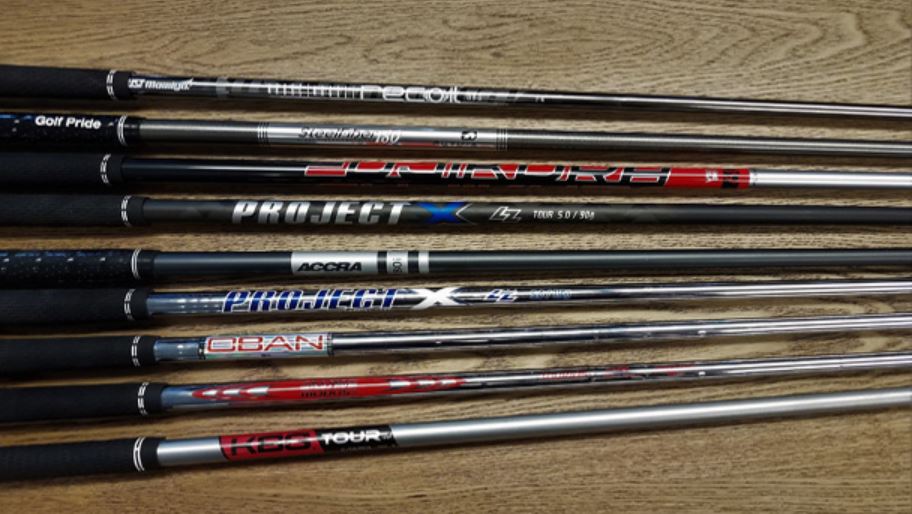Should Beginners Use Graphite Or Steel Shafts In Their Irons?

Once we start to take a more advanced interest in golf, we quickly learn that there is more than meets the eye when it comes to golf club composition and that is especially true with irons.
There are all different types of irons like distance irons, players irons and game improvement irons but there is also a choice between the material that the shaft is made of. Graphite and Steel are the two main materials used and they both suit different types of players.
Graphite Shafts tend to be lighter and lend themselves to players that don’t swing the club quite as fast and since graphite shafts have burst onto the scene in golf, steel shafts have really upped their game in recent times to try and keep up and now you can finder lighter and more flexible steel shafts for average swingers.
An Overview Of Steel And Graphite Shafts
Steel has traditionally been used in all clubs historically, known for its tough strength and durability but as technology has advanced, all golfers have found a lot of utility in using graphite shafts which are now almost exclusively used in Drivers, Fairway Woods and Hybrids.
For irons, the jury is still very much out. The extra speed and smoothness in the graphite makes sense for it to be used in the longer clubs like the driver and woods, but steel shafts can provide more control, stability and workability in irons.
Plenty of golf club sets for beginners now come with a choice between graphite or steel in their irons and in this article we are going to break down the key benefits of each type of shaft
Steel Vs Graphite Shafts Key Differences

The choice of steel vs graphite shafts is going to come down to each individual golfers preferences and as mentioned, your best option is to try out as many variations as possible before committing to an iron shaft.
The Differentiating factors between Graphite and Steel are as follows:
Weight:
By it’s very nature, steel is a heavier material than graphite and steel shafts tend to weigh quite a bit more than their graphite counterparts.
As steel shafts try to replicate some of the benefits of graphite, they are also getting lighter as time goes by.
The same is true for graphite shafts, they have come a long way in a short space of time. Nowadays you can find graphite shafts that offer much more control and stability than you could in years past.
Flex:
Having the right flex in your shafts, regardless of the material is also going to have a big impact on your overall performance.
Too stiff and you are likely to slice the ball and too flexible and you are likely to hook it.
Graphite is also a more flexible and smooth material by nature and you would expect graphite shafts to bend a bit more naturally when you swing the club.
There can be choices of flex for both steel and graphite from Lite to regular to stiff to senior flex but the more flexible of the 2 is likely to be the graphite shafts.
For players who don’t have as much swing speed, you are likely to find senior, ladies and even regular flex more often in graphite irons, but, again it is important that you get the right shafts for your game.
Durability:
While graphite is made out of carbon fiber and has plenty of benefits especially for beginners and slower swingers, steel is a more durable material.
Being more durable, steel tends to last longer and not break down as quickly. Durability tends to be a bigger advantage for players who swing the club faster than average.
Kickpoint:
The kickpoint of a shaft is the point at which the club flexes.
A lower kickpoint will send the ball higher and a higher kickpoint will send the ball lower and will typically be found in steel shafts and suit faster swingers.
Forgiveness:
Graphite is a much smoother material and a graphite shaft can really work to dampen any vibrations through the shaft when you miss the sweet spot of the club.
I remember when I started out playing as a junior with steel shafts and when you missed the sweet spot with on the club head, the vibrations would rock your entire body and leave you hands in pain.
While steel shafts have improved a lot since then, it is still the case that mishit with steel irons can cause some uncomfortable vibrations through the shaft.
On the flip side of forgiveness, steel shafts offer more stability and can offer better players more control and workability in their irons, which is particularly important in the shorter irons and wedges.
What Are The Main Advantages Of Graphite Shafts

Lighter:
Graphite shafts are lighter and offer a attractive option for slower swingers like juniors, ladies and seniors.
More Speed:
Because it’s lighter, we can generate more club speed which in turn leads to the ball going further up to a certain point. When the swing is too fast it can be harder to control graphite in your iron shafts.
More Forgiving:
As we already touched on, when we hit off center on the club face with a steel shaft, the vibrations can hurt, that is mitigated significantly when we switch to graphite irons.
Who Should Use Graphite Irons
Graphite Irons are perfect for players with slower swing speeds. Ladies, Seniors and juniors can benefit a lot from the lighter graphite shafts as they can swing the club faster and hit the ball further.
High handicappers and beginners often tend to miss the sweet spot of the club and with the graphite, the vibrations through the shaft will be a lot more forgiving, allowing beginners to learn how to play their irons correctly without as many repercussions on off centre hits.
Advantages Of Steel Shafts

As players get better or learn to swing the club faster, the choice of steel in their irons shafts makes more and more sense.
Stability
As swing speeds get faster, graphite irons can become too light and flexible to keep under control and a steel shaft will provide the stability needed to keep the club and swing with the correct form.
Lower Dispersion
Steel irons are more consistent and the dispersion’s or average difference between each shot is less for a steel iron. Steel irons have the effect of providing a more consistent end result.
Control And Workability
As we improve in golf, working the ball more becomes more important, especially around the greens and the tough, durable steel shaft offers more in the way of control and workability, ie, putting more spin on the ball and stopping it dead on the green.
Who Should Use Steel Iron Shafts
Steel irons are going to mainly suit anybody who swings the club faster than average. The extra stability will lead to more accuracy and consistency with the steel shaft.
Mid to low and the pros themselves all use steel shafts in their irons. These players will see a bigger advantage in the extra control and consistency afforded them by the steel irons.
For Drivers, Fairway Woods, Hybrids and maybe even driving irons will almost always have steel shafts while the better players and fast swingers will go for the extra strength of the steel in their irons and the same is true for wedges where accuracy around the greens is paramount.
Do Any Pros Use Graphite Irons

As you get to the better players and they are using blades and players irons, it is very rare to see pros using graphite shafts but that is all changing quickly.
Graphite shafts are now available in stronger, sturdier and much stiffer versions and we are seeing pros like Bryson Dechambeau even using graphite shafted irons now. Another example is Tiger Woods moving to a graphite shaft in his driving irons not so long ago.
Steel and graphite shafts are both improving quickly so keep an eye on this space moving forward.
How Important Is It To Have The Right Material
Having the right material in your clubs is going to be quite important, especially for beginners whose game and swing are just starting to take shape.
If you club is too heavy, you are going to lose distance and hit the ball low and if it is too light, you are likely to hit it too far in the air.
If you are using the wrong material in your shafts, you are likely to try and adapt your game to make use of the incorrect equipment and your game can suffer long term damage.
Fittings are getting much better and more accurate these days and getting a fitting is well worth the effort at the end of the day.
How Important Is It To Have The Right Shaft Flex
Having the right shaft flex in your irons is equally as important as having the right material in the first place.
If your shaft is too stiff you are going to end up with lower shots and a slice. You are likely to try and compensate for this in your swing.
If the shaft is too flexible, you are going to be hitting the ball too high and hooking it.
Measuring your swing speed and getting the right club make up is a very important step.
How Can I Measure My Swing Speed?

Measuring your swing speed is a lot easier now than it used to be. There are a range of personal launch monitors on the market nowadays for as little as $100 dollars.
Golf Simulators are also far better than they ever have been in the past and that is what you are likely to use in a pro shop during a fitting.
You can test out a variety of different shafts and see your exact performance with each one.
Getting a fitting for clubs or getting your current clubs fitted is the ideal way to make sure you are using the right shafts in your irons.
Steel Or Graphite Shafts In Wedges
Steel is going to be used by average to fast and all better player for the extra stability and control it offers around the greens.
For players with slower swing speeds, graphite might still be the better option to get the club moving a little bit faster and getting the ball up and the air and towards the green.
Conclusion
Choice of shafts is incredibly important in golf. Both steel and graphite have improved dramatically in recent years.
Steel is now available lighter and more flexible while graphite is now available in heavier versions with more stiffness and robustness.
We recommend for almost everyone with average to higher swing speeds to consider steel and people in the slower swing speed classes to opt for
Aidan Lehane here, I’m a Mid-low handicap golfer who has made tremendous progress in breaking 90 in just over 1 year of playing golf seriously.
I get out to the course or range as often as possible and review all the equipment I’ve come across on this blog.
